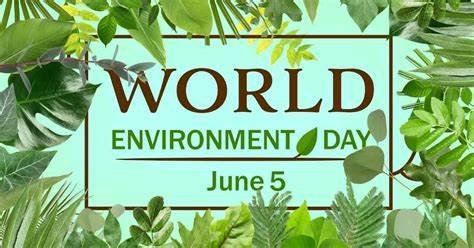World Environment Day: Beat Plastic Pollution – A Global Call to Protect Our Planet

Waking up in a world where rivers run clear, forests thrive with wildlife, and the air is fresh may seem like a dream, but it’s a future we can create. Our environment is the foundation of our health, well-being, and future. It’s not just where we live, it’s what sustains us.
The choices we make each day shape the future of our planet. From the water we drink to the air we breathe, everything is connected to the environment. World Environment Day serves as a vital reminder: protecting our planet is not just a responsibility, it’s essential for the survival of all living beings, including future generations.
History of World Environment Day
World Environment Day (WED) has a remarkable history. It began on the first day of the 1972 United Nations Conference on the Human Environment, the first major global gathering to focus entirely on environmental issues.
The idea didn’t come out of nowhere. In 1968, Sweden proposed the concept of hosting a global environmental conference. A year later, the United Nations agreed, and plans were made to hold the event in Sweden.
The conference finally took place in 1972 after four years of preparation and a $30 million investment. It was chaired by Canadian diplomat Maurice Strong, a passionate advocate for the environment.
Two years later, in 1974, the first World Environment Day was celebrated with the theme “Only One Earth.” Since then, it has grown into a global movement.
Traditions of World Environment Day
World Environment Day encourages everyone, individuals, schools, companies, and governments, to reflect on their impact on the environment and take steps toward a more sustainable future.
Activities include cleanup drives, planting trees, hosting workshops, and educational programs for people of all ages, including children.
2025 Theme: “Beat Plastic Pollution”
This year’s theme, “Beat Plastic Pollution,” highlights the growing crisis of plastic waste. Plastics threaten wildlife, ecosystems, and even human health. Microplastics are now found in our soil, oceans, food, and even inside our bodies.
The campaign urges everyone, governments, businesses, schools, and families, to reduce plastic waste and shift toward sustainable alternatives.
Why World Environment Day Matters
1. It raises awareness
World Environment Day educates people about the importance of managing our planet’s resources and ecosystems sustainably. It helps spread the message to friends, families, and communities.
2. It reconnects us to nature
Many of us forget how closely our well-being is tied to the natural world. Celebrating WED helps us remember that we are part of nature, and nature takes care of us when we take care of it.
3. It inspires action
Pollution harms our health, leading to respiratory problems and diseases like cancer. By raising awareness, World Environment Day motivates individuals and communities to act, cleaning our air, water, and land for a healthier future.
Plastic Pollution: Alarming Facts
- By 2060, the 400 million tons of plastic produced annually are expected to triple (UNEP, 2025).
- Only 9% of all plastic ever made has been recycled. The rest has been landfilled, burned, or polluted our planet.
- Every year, about 11 million tons of plastic enter the oceans, the equivalent of 2,000 garbage trucks dumping waste into waterways every single day (UNEP, 2025).
- By 2050, there could be more plastic than fish in the ocean (EMF, 2016).
- One million seabirds and over 100,000 marine mammals die each year from plastic pollution (UK Government, 2018).
- Plastic accounts for 80% of all marine debris studied worldwide (IUCN, 2021).
How to Celebrate World Environment Day
Here are some meaningful ways people of all ages can participate:
1. Take Part in Cleanup Campaigns
Join efforts to clean rivers, parks, forests, beaches, or your school playground.
2. Reduce Single-Use Plastics
Avoid using plastic straws, bags, and cutlery; rather use reusable bottles, paper shopping bags, etc.
3. Plant Trees
Participate in tree-planting activities to combat carbon emissions and create greener cities.
4. Plan Awareness Initiatives
Organize workshops or presentations in schools or communities to teach about plastic pollution and eco-friendly habits.
5. Get Creative on Social Media
Share your actions using hashtags like #WorldEnvironmentDay and #BeatPlasticPollution. Encourage friends and family to join the movement.
Conclusion
World Environment Day is an opportunity to make a difference. Everyone has a role to play in sustaining our environment. On this World Environment Day, let’s commit to a healthier planet for ourselves and our children.





